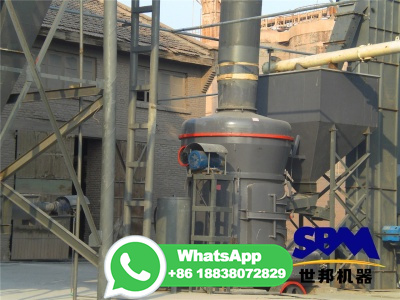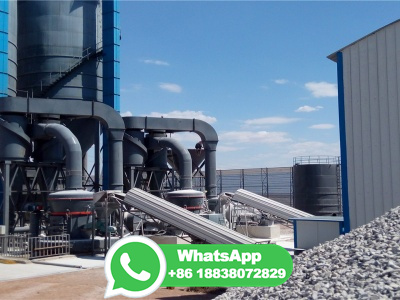
Iron is mainly extracted from hematite (Fe 2 O 3) and magnetite ores. Natural or direct shipping iron ores contain between 5070% iron and can be fed directly into the blast furnace. Fe 3 O 4 decomposes when heated to ferrous oxide (FeO) and ferric oxide (Fe 2 O 3) via Fe 3 O 4 → FeO + Fe 2 O 3. A specialized type of coal, called hard coal ...
WhatsApp: +86 18203695377
The quality of Indian iron ore resources is generally good with high iron content and high percentage of lumpy ore. More than 85% of the hematite ore reserves are of medium to highgrade (+62% Fe) and are directly used in blast furnace and in directreduced iron (DRI) plants in the form of sized lump ore, agglomerated sinter, and agglomerated pellets (Iron and SteelVision, 2020).
WhatsApp: +86 18203695377
If iron ore is reduced with H 2, instead of with coke or mixtures of H 2 and CO, water is formed instead of CO to the traditional BF route, direct reduction of iron with H 2 is kinetically favourable [7] and could reduce energy demand of the steel plant since there is no need for onsite coke production, sintering and pelletization [8].However, reduction of iron ore with H 2 is an ...
WhatsApp: +86 18203695377
Order my new children's book on Amazon! Orville the Iron Ore on Amazon: https:///2IXVkFiSteel and iron is an essential part of our everyday life. It m...
WhatsApp: +86 18203695377
Making steel. At Scunthorpe, we use the Basic Oxygen Steelmaking (BOS) process our modern convertors (or vessels) take a combined charge of scrap and liquid iron of up to 330 tonnes and convert this into steel in just 25 minutes. When the liquid iron arrives at the BOS Plant, it's poured from the torpedoes into refractorylined charging ...
WhatsApp: +86 18203695377
Presentation will help to provide basic principle and brief overview of iron making to steel making process. which is cover each and every stage of iron and steel making process along...
WhatsApp: +86 18203695377
In the steelmaking process, the iron enters the BOF and EAF after pretreatment to smelt into crude steel. The carbon is mainly from the gas fuel, with a small amount from the carboncontaining melt, iron and scrap. ... (2022) Assessment of variable solar and grid electricitydriven powertohydrogen integration with direct iron ore reduction ...
WhatsApp: +86 18203695377
The advantage of steel over iron is greatly improved strength. The openhearth furnace is one way to create steel from pig iron. The pig iron, limestone and iron ore go into an openhearth furnace. It is heated to about 1,600 degrees F (871 degrees C). The limestone and ore form a slag that floats on the surface.
WhatsApp: +86 18203695377
A shortage of highquality iron ore in the marketplace presents a significant hurdle for steelmakers who are trying to reduce their carbon emissions. Green hydrogenbased technologies use less carbon to produce steel, but the process requires higher iron ore grades than traditional blast furnaces. A dearth of ore with an iron content above 65% ...
WhatsApp: +86 18203695377
Making iron and steel from iron ore requires a long process of mining, crushing, separating, concentrating, mixing, agglomeration (sintering and pelletizing), and shipping to steel mills. Iron ore processing is characterized by a constant adaptation to changing raw materials and market conditions. It is the link between the mined raw materials ...
WhatsApp: +86 18203695377
First, the raw materials, either iron ore or scrap iron (depending on the process), are converted into molten steel. The orebased process uses a blast furnace or smelter and the scrapbased process uses an electric arc furnace. Next, the molten steel is poured and solidified in a continuous caster.
WhatsApp: +86 18203695377
Steelmaking is the process of producing steel from iron ore and/or scrap.
WhatsApp: +86 18203695377
The process continued for nearly a billion years and eventually let to the accumulation of oxygen in the atmosphere. ... Pig iron is an intermediate step in the production of steel and is produced by smelting iron ore (commonly in lump, pellet or sinter form) in blast furnaces. Blast furnaces in Australia are located at Port Kembla and Whyalla ...
WhatsApp: +86 18203695377
Steel production causes significant emissions of carbon dioxide. To decarbonize steel production and its high carbon dioxide emissions, Fraunhofer researchers, TS ELINO and Salzgitter AG are working on converting an existing steel mill to climateneutral production methods. The aim is to produce steel by the direct reduction of iron ore with hydrogen, which would completely replace ...
WhatsApp: +86 18203695377
Electrical powerbased iron reduction technologies use electricity to produce steel by means of iron ore electrolysis at different temperature levels (lowtemperature iron electrowinning, hightemperature pyroelectrolysis). ... DRNG process DRH 2 process; Iron input material: kg t −1 DRI: : : DRI temperature °C: 730: 730 ...
WhatsApp: +86 18203695377
Process. Direct reduction processes can be divided roughly into two categories: gasbased, and coalbased. In both cases, the objective of the process is to remove the oxygen contained in various forms of iron ore (sized ore, concentrates, pellets, mill scale, furnace dust, etc.), in order to convert the ore to metallic iron, without melting it (below 1,200 °C (2,190 °F)).
WhatsApp: +86 18203695377
Molten iron is produced in a blast furnace by the following steps: 1. Charge (solid iron ore, coke, and limestone) is constantly dumped into the top of the furnace. 2. A blast of hot air is blown into the furnace from the bottom. 3. Coke is the fuel that supplies additional heat, increasing the temperature of the charge. 4.
WhatsApp: +86 18203695377
Steel production is highly reliant on coal, which is primarily used as a reducing agent to extract iron from iron ore and to provide the carbon content needed in steel. Over the past decade, total CO2 emissions from the iron and steel sector have risen, largely owning to increases in steel demand.
WhatsApp: +86 18203695377
Electra's iron is the fulcrum to decarbonize steelmaking and to derisk the iron ore challenge. Our team, starting with a clean sheet, developed an electrochemical process to refine iron ore to high purity iron by radically lowering the process temperature from 1,600 to 60 degrees Celsius, replacing coal energy with intermittent renewable ...
WhatsApp: +86 18203695377
In this new process, iron ore fines are mixed with sustainable raw biomass material (like agricultural waste) and heated using a combination of gas released by the biomass and high efficiency microwaves powered by renewable energy, turning the iron ore into metallic iron. ... But the process of making steel from iron ore takes a lot of energy ...
WhatsApp: +86 18203695377
China iron ore imports vs SGX price RISING IMPORTS. In the first 10 months of the year official customs data show imports of million metric tons, an increase of % over the same period ...
WhatsApp: +86 18203695377
This process uses scrap steel products and iron ore as raw materials in a shaft furnace for the production of steel. Scrap allows reducing the specific energy consumption and CO 2 emissions of the process (as it is already in a reduced state), while iron ore helps diluting the tramp elements present in scrap.
WhatsApp: +86 18203695377
With thousands of years of development and two centuries of industrialization, making iron and steel is a mature process around the world. In 2011, manufacturers produced around 100 billion metric ...
WhatsApp: +86 18203695377
1. The Bessemer Process The Bessemer steel making process consists of blowing air through molten pig iron contained in a special furnace known as a converter which shaped like a huge concrete mixer (Fig. ). The converter is made of steel plates lined inside with a refractory material.
WhatsApp: +86 18203695377
Making steel Steel is made from iron ore, a compound of iron, oxygen and other minerals that occurs in nature. The raw materials for steelmaking are mined and then transformed into steel using two different processes: the blast furnace/basic oxygen furnace route, and the electric arc furnace route.
WhatsApp: +86 18203695377
On average, the recycled steelEAF process uses 800 ... The BFBOF route produces steel using raw materials such as iron ore, coal, limestone and scrap steel. First, iron ores are reduced to iron (hot metal, or pig iron), and then the iron is converted to steel in the BOF. After casting and rolling and coating, the steel is delivered as strip ...
WhatsApp: +86 18203695377
The only source of primary iron is iron ore, but before all that iron ore can be turned into steel, it must go through the sintering process. Sinter is the primary feed material for making iron and steel in a blast furnace.
WhatsApp: +86 18203695377
At the most basic, steel is made by mixing carbon and iron at very high temperatures (above 2600°F). Primary steelmaking creates steel from a product called "pig iron.". Pig iron is smelted iron, from ore, which contains more carbon than is correct for steel. The steelmaker uses a system that bubbles oxygen through melting pig iron.
WhatsApp: +86 18203695377
By helping steelmakers curb their greenhouse gas emissions, iron ore miners can advance their own decarbonization efforts. Decarbonizing steel production, which generates about 7% of global CO 2 emissions, is a vital step toward achieving a netzero world.
WhatsApp: +86 18203695377
A furnace is constructed: the smallest is a cylinder about three feet high, but they can be much larger. Iron ore and charcoal are dumped into the furnace, in alternating layers; it helps to add lime as well. A fire is started, perhaps air is pumped in the bottom with a bellows. ... which resulted in a "mild steel". This process, however ...
WhatsApp: +86 18203695377